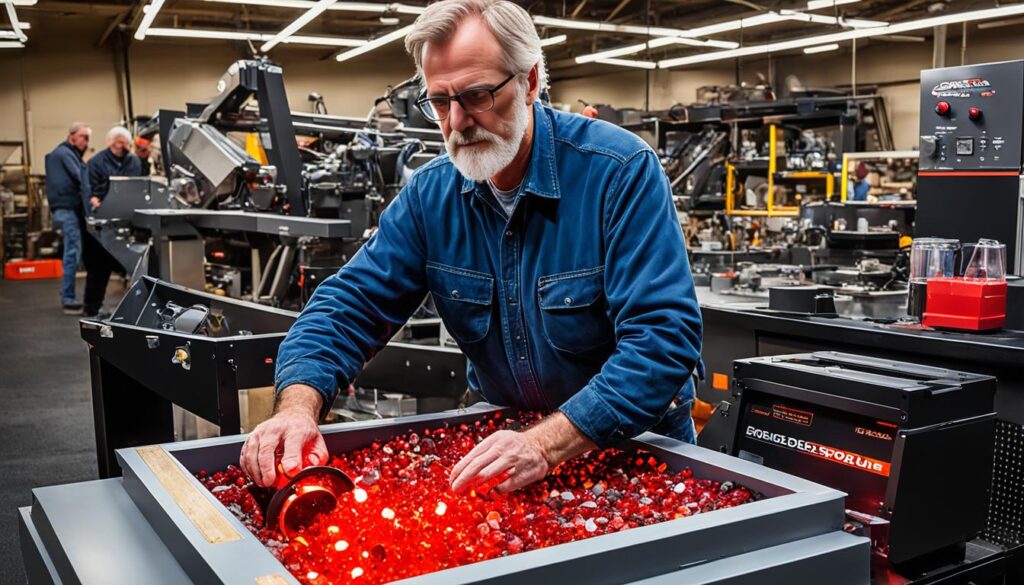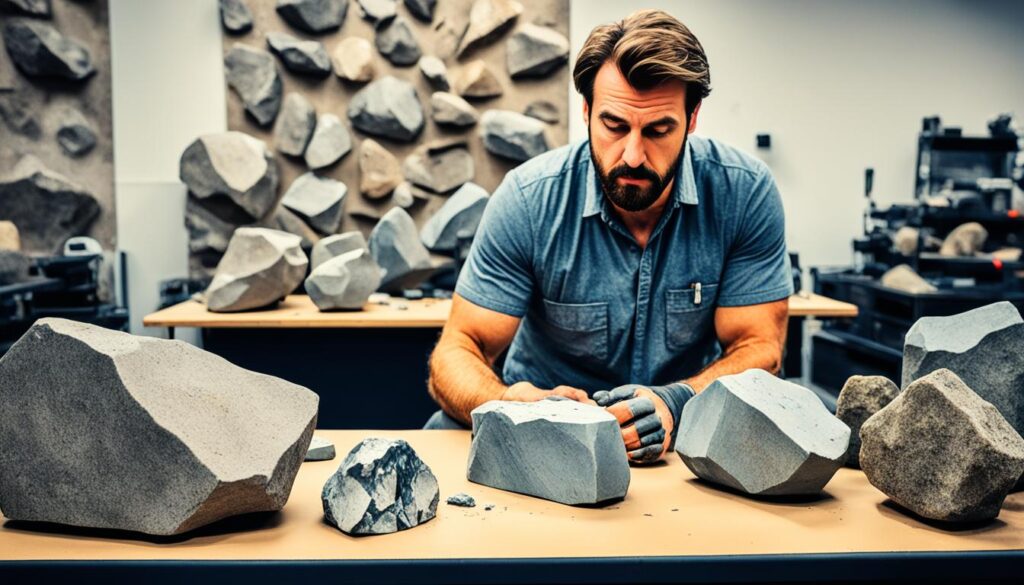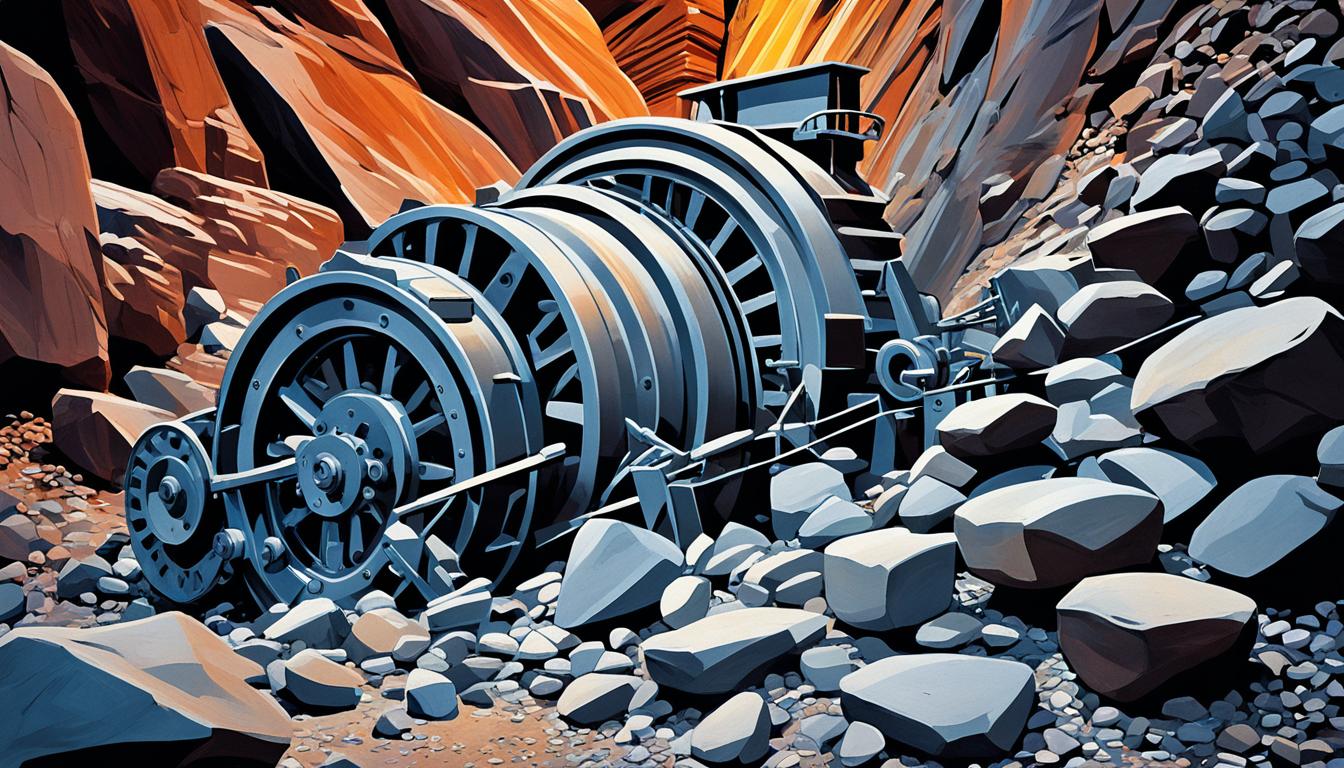This post contains affiliate links.
The journey from jagged stone to polished gem is no swift flight. As a rock tumbling enthusiast, how long does rock tumbling take? This question mirrors the eager curiosity of every beginner, and echoes in the chambers of seasoned practitioners. The art of rock tumbling is more akin to a marathon than a sprint, where the beauty of time is etched into the very stones you polish.
Often spanning 26 to 37 days, rock polishing duration is influenced by a symphony of factors—from the type of stone to the efficacy of your equipment. This transformative process unfolds in multiple stages, each essential in sculpting a stone’s rough potential into a lustrous treasure. Dive into this alluring sphere, as we peel back the layers of time, to uncover the sparkling heart of rock tumbling’s appeal.
Key Takeaways
- Anticipating the time period for rock tumbling goes hand in hand with understanding its artful evolution.
- Patient attention to the rock tumbling stages crafts the path from unrefined to radiant.
- Each phase—coarse grinding, medium grinding, fine grinding, to polishing—is critical.
- Recognize how factors like rock composition affect rock tumbling’s timeline.
- Acknowledge and embrace the dedication required for this rewarding craft.
- Consider the inherent charm found in the patient process of rock polishing.
Discovering the Marvel of Rock Tumbling
The art of rock tumbling captures the heart with its simple premise – take what nature roughened and polish it to perfection. You’re not just grinding down edges; you’re nurturing an unseen beauty waiting to escape from the core of the humblest pebbles. It’s a hobby that extends beyond age and background, ensnaring the curiosity of those brand new to it and further enchanting veteran collectors. Behind each glossy finish lies the rock tumbling process, which is far from mundane. Each step is a stroke of an invisible brush, slowly crafting a masterpiece from the most unassuming canvases: raw stones.
The Process and Its Magical Transformation
Imagine the magical transformation of rocks, a true metamorphosis that occurs beneath the steadfast gaze of the tumbler’s lid. It begins with jagged edges, striated surfaces, and the stones’ unrefined essence, all tumbling headfirst into an adventure of renewal. Through the rolling, rattling, and whisper of grit against mineral, the extraordinary occurs. From rough to smooth, from dull to brilliant – witness the unveiling of inherent splendor as each phase in the tumbling cycle brings us one step closer to nature’s hidden art.
From Novice to Aficionado: Rock Tumbling’s Growing Appeal
Why does this pastime beckon so persistently? It could be the thrill of uncovering what’s beneath, or perhaps it’s the satisfaction of creation that drives your passion. The rock tumbling popularity is more than a trend; it’s a growing community where knowledge is shared, and the love for the craft is as palpable as the polished stones themselves. As your hands uncover the treasures that have been rounded and refined, know that you are part of an expanding brotherhood and sisterhood of artisans who take pride in bringing the earth’s concealed beauty to light.
Essential Equipment for Rock Polishing
Stepping into the realm of rock polishing, you’ll quickly find that your rock tumbler is more than just a device; it’s the cornerstone of a fascinating craft. But remember, the results you strive for won’t be achieved with the tumbler alone. Let’s delve into the essential rock tumbler supplies that will help you transform simple stones into captivating gem-like treasures.
The Rock Tumbler: Your Tool for Transformation
The rock tumbler is your primary tool in the pursuit of rock polishing. Choosing a high-quality rock tumbler can spell the difference between an average outcome and a magnificent one. A sturdy, reliable machine is a must-have for anyone serious about this art.
Must-Have Rock Tumbler Supplies for Every Enthusiast
A seamless rock polishing journey calls for an inventory of indispensable supplies:
- Grits: An assortment of grits, from coarse to fine, is fundamental in gradationally refining your rocks. Your rocks will undergo stages, and each stage requires its specific type of grit to prepare the stones for the next phase effectively.
- Polishing Compounds: To achieve that sought-after gleam, polishing compounds are necessary. These compounds bring out the shine after the stones have been smoothed by the grit.
- Cushioning Media: To safeguard your stones and provide for a consistent polish, cushioning media is often integrated into the tumbling process, especially when working with delicate stones.
As you accumulate these essential rock polishing equipment, you’ll discover how each plays a vital role in the creation of your polished stones. Whether you’re a beginner or you’re refining your craft, escalating from a collection of rock tumbler supplies to awe-inspiring geological pieces underlines the true value of quality equipment. Invest wisely and watch as your skills flourish.
The Sequential Stages of Rock Tumbling
Embarking on the journey of transforming rough rocks into polished gems is a thrilling process that involves patience and attention to detail. Let’s explore the sequential rock tumbling stages that will guide you through this mesmerizing transformation.
The Foundation: Coarse Grinding
You begin with coarse grinding, the vital first step in shaping your stones. During this phase, your rocks will spend 7-10 days in a gritty embrace, slowly shedding their jagged edges and revealing the possibility of hidden beauty beneath their rough exteriors.
Transition to Perfection: Medium and Fine Grinding
Once the coarse edges have been worn away, it’s time to refine the stone surfaces with medium and fine grinding. These stages, each spanning another 7-10 days, layer upon the foundational work of the coarse grind, smoothing your stones to near-perfection, and preparing them for their final luster.
The Final Touch: Rock Polishing Techniques
In the final 5-7 days, you’ll employ specialized rock polishing techniques to give your stones a gleaming finish. This is where the true transformation occurs, as polishing compounds work their magic, turning your rocks into treasures with a brilliant shine.
| Stage | Duration | Purpose | Grit Used |
|---|---|---|---|
| Coarse Grinding | 7-10 Days | Shaping and smoothing rough edges | Coarse Grit |
| Medium Grinding | 7-10 Days | Refining the surface | Medium Grit |
| Fine Grinding | 7-10 Days | Further smoothing and pre-polishing | Fine Grit |
| Polishing | 5-7 Days | Imparting a high shine | Polishing Compound |
Progressing through the rock tumbling stages can be a mesmerizing experience. As you witness the gradual transformation, your sense of achievement will grow along with the luster of your stones. Keep these stages in mind, and soon you’ll hold the tangible result of your effort and patience—a collection of your very own polished stones.
THE ART OF ROCK TUMBLING: HOW LONG DOES IT REALLY TAKE?
Embarking on your rock tumbling journey, you might be pondering the rock tumbling duration required to transform coarse stones into polished gems. Delightfully, this craft elegantly bridges science and art, blending the gritty mechanics of a tumbler with the natural allure of the stones. But remember, rock polishing completion time is not a sprint; it is more akin to a marathon, requiring patience and persistence.
With the magic of rock tumbling spanning typically between 26 to 37 days, the longevity of rock tumbling can be both a meditative and rigorous endeavor. Each polishing cycle reflects meticulous care and attention, as it is influenced by more than just the ticking clock. The hardness of the mineral, the size of the stone, and the tumbler’s capacity all interplay to determine the journey’s length.
Here’s a glance at the typical durations you can expect in the stages of rock tumbling:
| Stage | Time Required | Comments |
|---|---|---|
| Coarse Grinding | 7-10 days | First step where initial shaping occurs. |
| Medium Grinding | 7-10 days | Further refines shapes and smooths edges. |
| Fine Grinding | 7-10 days | Prepares the surface for polishing. |
| Polishing | 5-7 days | The final step to achieve that desired shine. |
| Total Duration | 26-37 days | Overall time until rock polishing completion. |
As you can see, the process’s pace is steady, but each phase is significant, drawing closer to a climactic reveal of sparkling allure. It is a gratifying experience, tailored to both the stones and your growth as an artisan. Whether you’re new to the craft or an experienced tumbler, acknowledge that rock tumbling duration is an intricate dance – one where nature and nurture lead to enduring, polished beauty.
Factors Influencing Tumbling Times
As you delve into the world of rock tumbling, understanding the key elements that determine the duration of the tumbling process is crucial. Gaining knowledge on the aspects that could affect how long you’ll be waiting for those gleaming results can be extremely valuable in planning your tumbling schedule.
Rock Type Variability and Its Impact on Duration
The type of rock you choose to tumble plays a significant role in the time it takes to achieve the desired level of polish. Each rock type has a unique mineral composition, which determines its hardness and reacts differently during the tumbling process. Softer rocks like calcite may tumble more quickly than harder varieties such as quartz, influencing the duration of each tumbling phase. Let’s take an informative look at how different rock types can impact your tumbling timeline.
For instance, consider the Mohs scale of mineral hardness, which classifies minerals on a scale from 1 (softest) to 10 (hardest). Rocks with a lower rating will generally require less time to grind and polish as opposed to those with a higher rating.
Shape, Size, and Tumbler Type Considerations
The physical attributes of the rocks, mainly their shape and size, also dictate the tumbling duration. Smaller, more uniform rocks tend to require less time compared to larger or irregularly shaped stones that may necessitate extended tumbling to achieve uniformity and smoothness.
The type of rock tumbler you use is another pivotal factor — rotary versus vibratory. Rotary tumblers, which are more common among hobbyists, require extended tumbling times but yield exceptional rounding and smoothing. In contrast, vibratory tumblers are faster and ideal for retaining the original shape of the stones while still achieving a fine polish.
A table showcasing the typical tumbling times for different rock types, shapes, and tumbler models can help you better plan your tumbling activities:
| Rock Type | Rock Size | Tumbler Type | Estimated Tumbling Time |
|---|---|---|---|
| Calcite | Small (1/2″-1″) | Rotary | 3-4 weeks |
| Quartz | Medium (1″-2″) | Vibratory | 1-2 weeks |
| Agate | Large (2″+) | Rotary | 4-6 weeks |
Succinctly put, key rock tumbling factors like rock type impact and tumbler type considerations must be factored into your tumbling projects to anticipate the amount of time required for each batch of rocks. Tailoring your approach by assessing these factors can lead to a more efficient and satisfying rock tumbling experience.
Tips for Expediting the Rock Tumbling Process
If you’re seeking to streamline your rock tumbling journey, achieving quicker and effective results is likely on your mind. Enhancing the efficiency of your rock tumbling can significantly reduce the time it takes for those rough edges to evolve into polished gems. By selecting the right rocks and maintaining proper tumbler conditions, you can expedite the rock tumbling process without sacrificing quality.

Selecting the Right Rocks for Quicker Results
When expediting rock tumbling, the type of stone you choose plays a crucial role. Opting for naturally softer stones, such as soapstone or calcite, can significantly decrease the amount of time needed for tumbling. These types of rocks inherently require less time to become smooth and shiny, allowing you to enjoy your polished stones much sooner.
Maintaining Proper Tumbler Conditions to Save Time
Another key to speeding up the tumbling process is maintaining tumbler conditions. Consistency is your ally here; monitoring the tumbler for water level, ensuring the grit is properly balanced, and checking that the barrel isn’t overloaded are all necessary steps. This ongoing vigilance guarantees that your tumbler operates at peak efficiency, potentially moving your rocks to the polishing phase sooner than expected.
| Type of Stone | Hardness (Mohs Scale) | Tumbling Time (Weeks) |
|---|---|---|
| Soapstone | 1 | 2-3 |
| Calcite | 3 | 3-4 |
| Amethyst | 7 | 4-5 |
| Quartz | 7 | 4-5 |
Remember, the beauty of rock tumbling lies not only in the final result but in the process itself. While it’s appealing to expedite rock tumbling, it’s also essential to embrace each step of the transformative journey. By carefully selecting the right rocks and maintaining tumbler conditions, you can enhance your experience and enjoy your spectacular polished stones in no time.
Understanding the Grits: From Coarseness to Polish
When it comes to transforming rough stones into mesmerizing polished gems, the secret lies in the strategic use of rock tumbler grit. Each form of grit plays its own unique role, so understanding the grit coarseness levels relevant to each stage can be the difference between a good finish and a great one. Are you ready to dive in and learn the subtle art of optimizing grit usage for a dazzling shine? Let’s get started.
The Role of Rock Tumbler Grit in the Tumbling Process
As a rock tumbler enthusiast, your first encounter with raw stones is just the beginning. The real transformation starts with coarse grit that strips away imperfections. Progressively finer grits then step in to smooth and eventually polish the surface of your rocks to perfection. This incremental gradation is crucial for achieving the glossy sheen that makes rock tumbling so rewarding.
Optimizing Grit Usage for Efficiency and Shine
By tailoring the amount and type of grit to your stones’ needs, you champion both efficiency in the tumbling process and luster in the final results. Keeping a close eye on your grit supply, ensuring that you don’t run out or overuse, is pivotal for the craft. Paying attention to meticulous steps can be the difference between a rock that’s been tumbled and one that truly stands out.
| Grit Coarseness Level | Typical Usage | Expected Results |
|---|---|---|
| Coarse (60-90 grit) | Initial shaping and edge smoothing | Significant shaping, removal of jagged edges |
| Medium (120-220 grit) | Smoothing surfaces after coarse grind | Smoother textures, preparation for fine grit |
| Fine (500 grit) | Pre-polish, refining surface smoothness | Very smooth surfaces ready for polishing |
| Polish (1000+ grit or polish compound) | Final step, enhancing shine | Brilliant polish, gem-like appearance |
Whether you’re a seasoned polisher or just starting out, paying attention to grit coarseness and its appropriate usage means you’re not only working smarter but also more effectively. Now that you have the knowledge, you’re well on your way to taking your rock tumbling from a simple pastime to a shining, gleaming hobby that produces true works of art.
Troubleshooting Common Rock Tumbling Challenges
Embarking on the journey of rock tumbling, you envision a trove of gleaming stones, each a testament to your skill and patience. Yet, at times, the rocks emerge from their gritty dance less than perfect, beset by scratches, or simply lacking that anticipated sparkle. Troubleshooting rock tumbling setbacks is an integral skill, encapsulating the abilities of diagnosing polishing problems and preventing future blemishes. Let’s delve into the common obstacles and practical solutions to elevate your rock tumbling prowess to its polished peak.
When Rocks Don’t Shine: Diagnosing the Problem
The disappointment of unveiling dull stones after a rigorous cycle of tumbling is quite familiar to many hobbyists. The art of diagnosing polishing problems involves a careful examination of your process, a reassessment of the materials used, and an understanding that sometimes, small tweaks make significant impacts. It’s essential to observe if your grit progression is correct for the type of rocks you’re tumbling, whether each stage of the process has seen proper adherence to time, and if you’ve employed the right balance of water and grit.

Preventing Scratches and Irregularities During Polishing
Preventing scratches in tumbling is a proactive measure that saves time and preserves the quality of your final product. Scratches can often be a sign of not thoroughly cleaning between stages, leftover coarse grit can wreak havoc in your finer stages. Ensure each stone and the tumbler itself is clean before progressing. Additionally, consider the hardness of your stones; mixing different hardness levels can cause the softer stones to be scratched by their harder companions. Here, separating batches by hardness can maintain integrity and surface smoothness.
| Troubleshooting Aspect | Common Problems | Strategies for Resolution |
|---|---|---|
| Lack of Shine | Incorrect grit progression, short tumbling times, insufficient water | Review and adjust grit sequence, extend tumbling duration, ensure proper slurry consistency |
| Surface Scratches | Insufficient cleaning, hardness variability, improper grit size | Clean thoroughly between stages, separate stones by Mohs scale, validate grit size for stone type |
| Irregular Shapes | Over-tumbling, inconsistent sizes, aggressive tumbler speed | Monitor tumbling closely, sort stones by size beforehand, adjust tumbler settings |
Recognize that the art of rock tumbling is one of precision and patience. Each stage of the process interacts uniquely with your stones, and attention to detail is paramount. Whether it’s troubleshooting existing issues or refining your technique to prevent future challenges, every tumbling experience is an opportunity to sharpen your skills. With these strategies, you’re equipped not only to diagnose but to overcome common stumbling blocks, paving the way for smoother, shinier results in every batch of rocks you polish.
Expanding Your Rock Tumbling Knowledge
As you delve deeper into the world of rock tumbling, your desire to expand upon what you can achieve grows. With a keen appetite for knowledge, finding the right resources and supplies becomes paramount in your quest for crafting the perfect polished stone. It’s an exciting journey, one that’s enriched by learning from those who have honed their skills over years of practice.
Sourcing Quality Rock Tumbling Supplies and Information
Embarking on the search for quality rock tumbling supplies is the first step towards success. The market is filled with various brands and types of tumblers, grits, and polishers, and it’s crucial to select those that will best suit your needs. Let’s detail the must-have supplies that every enthusiastic rock tumbler should possess:
- Reliable Rotary or Vibratory Tumbler
- Assortment of Grits (Coarse to Fine)
- Polishing Compounds for High Shine
- Plastic Pellets or Ceramic Media for Cushioning
These supplies form the backbone of your tumbling arsenal, supporting you as you journey towards mastering the art.
Learning from Veteran Polishers: Rock Tumbling Tips and Techniques
True growth in any craft comes not only from practice but also from the absorption of knowledge passed down by veteran polishers. Their tips are invaluable, highlighting tricks and techniques that can transform your rock tumbling process. What’s some of their shared wisdom? Let’s take a quick peek:
| Tip | Benefit |
|---|---|
| Consistent Tumbler Maintenance | Ensures longevity and reliability of equipment |
| Never Overfill the Tumbler Barrel | Improves tumbling action and prevents jams |
| Keep a Tumbling Log | Tracks progress and helps refine the process |
| Careful Grit Gradation | Yields a smoother, more uniform polish |
Using these veteran polisher tips can greatly enhance your ability to produce beautifully polished rocks. Remember, there’s no substitute for hands-on experience, yet complementing your practice with this expertise can accelerate your growth immensely in the realm of rock tumbling knowledge expansion.
Environmental Considerations in Rock Tumbling
As you delve into the world of rock tumbling, it’s important to consider the environmental impact of rock tumbling. The practice, while rewarding, traditionally utilizes plastic pellets as part of the polishing process. These plastics, unfortunately, can contribute to environmental pollution if not disposed of correctly. In recent years, the community has taken strides towards responsible rock polishing by seeking out and employing plastic pellet alternatives.
The Issue of Plastic Pellets and Eco-friendly Alternatives
Plastic pellets have been a staple in cushioning and facilitating the tumbling process, but their use raises concerns over environmental sustainability. The good news is that there are eco-friendly options available that are just as effective. Ceramic media, for instance, has emerged as a popular alternative, offering a reusable and less polluting option for enthusiasts like you who wish to minimize their ecological footprint.
Responsible Rock Polishing: Minimizing the Environmental Impact
Becoming more eco-conscious doesn’t have to mean compromising on the quality of your tumbling. By opting for sustainable materials and practices, you can ensure that your hobby is not only fulfilling but also kind to the planet. Let’s consider a comparison between traditional plastic pellets and one of the popular eco-friendlier alternatives – ceramic media:
| Material | Pros | Cons | Environmental Impact |
|---|---|---|---|
| Plastic Pellets | Lightweight, inexpensive | Non-biodegradable, potential pollutant | High – contributes to plastic waste |
| Ceramic Media | Reusable, durable, less abrasive | Initial cost may be higher | Low – more environmentally friendly |
By choosing ceramic media over traditional plastic pellets, you ensure a sustainable practice that aligns with the tenets of responsible rock polishing. Every small change you make contributes to a larger impact, helping to protect our precious environment while you continue to enjoy the timeless art of rock tumbling.
Conclusion
The voyage through the landscape of rock tumbling is more than a pastime—it’s a celebration of patience and consistency. As you’ve learned, the artistry involved in this hobby correlates strongly with the degree of patience in rock tumbling that you exhibit. It’s a soothing rhythm that syncs with the natural world, teaching you to resonate with the time-honored tempo of transformation. Whether you spend 26 days or 37, your contributions to the patient shaping and polishing of each stone are what make the final product so uniquely captivating.
Embracing Patience in the Art of Rock Tumbling
Your journey from the start of the tumbling cycle to the rewarding end is a narrative punctuated by unwavering diligence. This craft demands attention to detail and a serene recognition that the hidden splendor of each stone can only be coaxed out with time. Embrace the slow dance of grinding, smoothing, and burnishing, for these are the moments where true artisans are forged. Remember, every minute devoted adds depth to the timeless treasures of rock polishing you are so fervently working towards.
Collecting Timeless Treasures: The Reward of Rock Polishing
The rewards of rock tumbling rewards exceed the lustrous surfaces of the stones themselves. They manifest in the irreplaceable collection you accumulate, each piece a testament to your dedication and skill. The shimmer of each finished gem embodies your partnership with time—a relationship built on persistent effort and a keen eye for the beauty that lies beneath. So, continue to cherish each tumble, each grain of grit, and every gleam that emerges from your rock tumbler. The treasures you garner along the way will be as enduring as the art of rock tumbling itself.
FAQ
How long does rock tumbling take?
What is the rock tumbling process?
Why is rock tumbling gaining popularity?
What is the function of a rock tumbler?
What supplies are essential for rock tumbling?
What are the sequential stages of rock tumbling?
What factors can affect the duration of rock tumbling?
How can I expedite the rock tumbling process?
How does rock tumbler grit contribute to the tumbling process?
What should I do if my rocks aren’t achieving a good shine?
Where can I find quality rock tumbling supplies and information?
What are some environmentally responsible practices in rock tumbling?
How important is patience in the art of rock tumbling?
Source Links
- https://polishingexpert.com/rock/how-long-does-rock-tumbling-take/
- https://rockstumbling.com/faq
- https://tumblestoneblog.wordpress.com/category/rock-tumbling-practicalities/
This post contains affiliate links.

